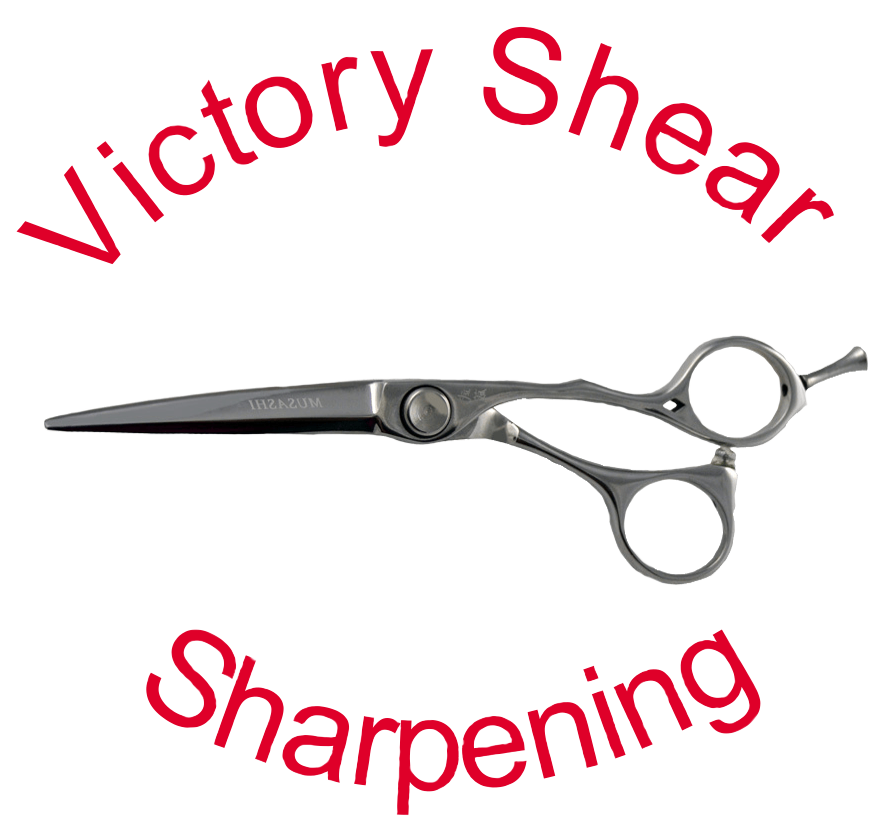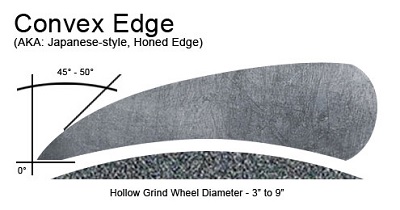

The properties that makes a Japanese-Style shear different than other types of shears:
The basic design of shears remained stable from about 1650 through the mid 20th century: essentially two straight blades with a beveled edge hinged in the middle with thumb and finger holes. This basic design was used for almost all applications, from fabric shears to barber shears. In the early 20th century, barber shears got a little more sophisticated and the “German-Style Shear” was produced. This basic design is still the straight, flat blade with a bevel edge, but the handle design changed to make it more comfortable when barbers were using them.
Roughly 50 years ago, in 1968, Fukutaro Takahashi (founder of Hikari Shears), changed the face of hair dressing with the introduction of what eventually became known as the Japanese-Style Shear.
 What made this design unique are two interrelated features:
What made this design unique are two interrelated features:
• The 800mm radius (a slight curve in the blade from hilt to tip)
and
 • The convex edge, which provides a sharper blade giving a much cleaner cut as the scissors melt through the hair. The radius changes the angle of attack when the scissors close holding the hair in place so you don't have the hair pushing away with each snip.
• The convex edge, which provides a sharper blade giving a much cleaner cut as the scissors melt through the hair. The radius changes the angle of attack when the scissors close holding the hair in place so you don't have the hair pushing away with each snip.
This design change radically affected the industry by giving stylists far more control and capability when cutting hair.
When you've had your shears sharpened several times (sometimes by several different sharpeners), but they don't cut the same as they did when they were new, and the reasons behind this:
There are several ways to sharpen shears.
The first is on a grinder. Here is a warning - grinders are great for German-Style shears but can quickly turn a $500 Japanese-Style shear into a $25 bevel edged shear.
The second upgrade in the sharpening industry came with the introduction of the flat hone or water hone system. These types of systems will at least maintain the convex edge in the blade. However, they do remove the radius so even though the blade may be very sharp, it will push hair.
The third advance in sharpening technology came with the introduction of the Diamond Rose Superior Sharpening System. This patented system is the first and still the only one that maintains or restores both unique features of the Japanese-Style Shear. So to answer your question: unless you had your shears sharpened by a certified sharpener using the Diamond Rose Superior Sharpening System, your shears will never cut the same as they did new.
Why Victory Shear Sharpening charges $25 per sharpening:
It is actually quite simple. I spend about 20 minutes to half an hour restoring a pair of shears using the finest system available. In most respects, I am fussier than my clients are and I have spent an hour or more restoring a particularly difficult pair of shears to factory-new condition. If getting your shears restored to factory-new cutting condition and extending their life is important to you, then the price should be looked at as an investment rather than a pure cost.
How you can tell the quality of the steel used in your shears:
Shear manufacturers will often state what steel they use, and it's quality, in their shears(if they don't it is usually because they don't want you to know how low the quality of stainless steel is that they are using). You can go onto their website to find out. Almost all shears are made from stainless steel. The majority of shears are made from steels that are rated as 330C steel or better. Higher quality shears will use steel that is rated as 440C or better. The Musashi Shears I sell are made from three different steels. The majority of our products are made from 440C with Cobalt and Molybdenum added for extra strength and sharpness. Our Diamond Series is made from V10 Gold Steel and our Damascus Series are all made from Damascus Steel.
I sharpen hundreds of scissors a month. When I sharpen, I can tell the quality of steel based on how the sharpening process goes. Musashi, Hikari and Nic shears have, by far, the best steel quality I see every day. I know that many stylists are trying to save themselves money by purchasing cheap or inexspenive shears (I understand that, I really do), but ask yourself this question: Would you want to go to a stylist to cut your hair who uses the cheapest shears he/she can buy?
If your sharpener told you that your shears are nearly shot and you'll have to replace them soon, this may or may not be true.
It really depends on a number of things. If you bought a really inexpensive pair of shears, it may not be worth doing anything except replacing them with another really inexpensive pair. But I have seen sharpeners say this about shears that cost $200 to $500 and more. A reasonably good pair of shears can last for years and a properly maintained high quality pair of shears can last your entire career. When it comes to hair styling shears, you really do get what you pay for.
That being said however, a bad sharpener can take years off your shears each time they sharpen them. A sharpener using a grinder will take off more metal than needed and not only will they ruin your shears but they will also reduce their life expectancy.
Using the patented Diamond Rose Superior Sharpening System I have restored shears to nearly factory-new cutting condition that had been ruined by a sharpener using a grinder where he literally took almost half the blade's metal off.
Beware of sharpeners who sell shears by telling you that you've only got 2 sharpenings left on the shear. They may be trying to sell you another “deal” that will need replacing in two more years.
Some shears salespeople may try to sell you shears that sharpen themselves with use.
If you hear this from a salesperson, run away. It is not physically possible to have self-sharpening shears. The fact is; all scissors will get dull from use. The higher the quality of the steel the slower the process. But if you're cutting hair every day, your scissors will need to be sharpened periodically. We recommend getting on a schedule where you get your shears sharpened every 3-4 months. A high-quality shear will last between 500 and 700 haircuts. But all that depends on a lot of other factors such as:
• Are you in a high-volume salon?
• Do you cut a lot of treated or dyed hair?
• Cutting a lot of coarse hair will quickly dull your shears.
• Cutting hair with extensions in it.
• Cutting anything other than hair with your shears.
Simply put, there are no scissors out there that sharpen themselves, it is not physically possible.
What to do when you drop your shears onto the floor.
Dropping your shears does not necessarily ruin them, but what you do next, after you pick them up off the floor is crucial. I suggest that if you drop your shears you immediately pick them up in exactly the same position they were in on the floor. Place them on a towel with the blades open and call me. Most times when shears get dropped, it will produce a small nick in the blade(s) when the blades bang together. If you close the shears, that nick can damage the other blade or scratch the hollow ground section of the opposing blade. I can, in most cases, simply resharpen them and get rid of the damage.
The question of whether or not it violates your warranty to have an independent sharpener like myself sharpen your shears.
This may or may not be true. Check the written copy of your warranty, or the manufacturers website. Very seldom does this actually violate the warranty. I sell one of the top 3 shears available in the U.S.: Musashi Shears. Our shears carry a lifetime warranty against factory defect. When I sell one of these great shears, I recommend that the stylist only use me to sharpen them since only I can maintain both the convex edge and the radius. However, some of my clients will take advantage of some other sharpener's deal and get them done by someone else. Most of the time I have to come in and fix what the other guy did but it still doesn't violate our warranty.
If you bought your shears from someone who told you this, there are two other things to be concerned about. I've seen stylists that have had to exchange their new shears several times before getting a pair that works. If you get 2-4 months out of the shears before they feel like they are getting dull, you're using a pair that have passed beyond the normal factory defect time-frame. The other thing that is often happening is that the sharpener is setting you up for future sharpenings.
Finally, when I finish sharpening a pair of shears, they cut like they were brand new. Ultimately, this is what every stylist wants.
What to do when a brand new pair of shears folds hair or does not cut properly.
Either you have a true factory defect in the shear and it needs to be replaced at no cost to you; or more, commonly the sharpener who sold you the shears did not prep them before delivering them to you. For a true factory defect, call your salesman and have the shears replaced immediately. If the shears were not properly prepped before delivery, call your salesman and have them come onsite and sharpen the shears from scratch.
How to test your shears for sharpness:
The best way to test the sharpness of your shears is to wet a Sanek-Strip® and make a slow (relaxed-no torqueing) cut through it, using the whole length of the blade. If they cut through cleanly without tearing or folding, your scissors are still sharp. If they don't and they bend or tear the Sanek-Strip®, they need to be sharpened. Dull scissors crunch or break the hair causing split ends. A dull pair of scissors also adds to your fatigue at the end of the day.
You'll probably need to leave me a voice message, but please do so. I'll call you back as soon as I’m free.
Call Me
Send me a text with your name, salon, and I'll get back with you as soon as I can.
E-mail is also a good way to ask questions that you might find to be convenient...